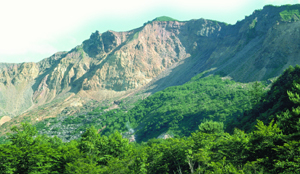 In July
1888, the north flank of Bandai Volcano in Japan catastrophically collapsed,
carving an enormous amphitheater-sized hole out of the mountain and carrying
a deluge of rock and debris to the valleys below. The avalanche of rock killed
461 people and buried several villages.
In July
1888, the north flank of Bandai Volcano in Japan catastrophically collapsed,
carving an enormous amphitheater-sized hole out of the mountain and carrying
a deluge of rock and debris to the valleys below. The avalanche of rock killed
461 people and buried several villages.The north flank of Bandai volcano in Japan catastrophically collapsed in 1888 — producing a debris avalanche that traveled 11 kilometers down the valley and caused 461 fatalities — but never erupted magma. New research suggests that Bandai and other such massive edifice collapses could be caused by pressurized groundwater systems at the volcano surface. Courtesy of Lee Siebert, Smithsonian Institution.
In May 1980, Mount St. Helens shook to life, engendering a similarly catastrophic collapse on its north face. By the time the rock and debris avalanche finished its run down the side of the mountain, it had destroyed 230 square miles of forest.
Although the two volcano collapses were quite similar in result, says Mark Reid, a geologist with the U.S. Geological Survey (USGS) in Menlo Park, Calif., there was one key difference: Mount St. Helens explosively erupted fresh magma whereas Bandai did not. For years, geologists have puzzled over what could cause these massive, horseshoe-shaped structural collapses on volcanoes with no eruption of magma. New research is now suggesting that shallow groundwater systems on the volcanoes could explain the difference.
In the May Geology, Reid reports that hot magma deep underneath the volcano — a few kilometers below the surface — could be heating the groundwater system above and increasing fluid pressures to the point that the hillside is no longer stable. This deep magma may never reach the surface, but still could cause a highly destructive edifice failure, which can scoop out half a kilometer of the hillside and shift up to 1.5 cubic kilometers of land as it travels down the slope.
While landslides and rock avalanches (up to 100 meters deep) are common on mountains and active volcanoes and frequently associated with earthquakes or heavy rains, deep edifice collapses are not as common, especially without an eruption. In the geologic record, however, edifice failures have sculpted at least 200 volcanoes worldwide, Reid says. Of the volcanoes Reid studied, some showed no evidence of magmatic intrusion into the edifice. But every volcano flank that collapsed had a shallow hydrothermal groundwater system within the edifice near the time of collapse — a coincidence Reid began to pursue.
Based on details from historical records of some massive structural failures, Reid numerically calculated how deep, or “far-field,” magma intrusions can affect water pressure and temperature in the groundwater systems. He found that in the models, the heat from remote magma sources temporarily elevated pore pressures in the fluid-saturated rock, which then propagated upwards into the volcano edifice. The elevated pore pressures destabilized the ground enough to provoke giant collapses.
Reid cautions, however, that ultimately, even with the right pressures and temperatures, other factors will determine whether the slope will fail. Highly permeable rocks in a volcano (such as at Kilauea in Hawaii), will dissipate fluid pressure, reducing the threat of massive hydrothermally driven collapse from deep magma intrusion, and low permeability in the edifice rocks will lead to fractures well before collapse. “These collapses need all the right conditions,” Reid says, which are not easy to detect. But knowing the conditions that may lead to this kind of collapse will help assess areas most at risk, he says.
Reid’s work is “another step toward helping us understand what’s going on deep inside a volcano, which ultimately helps us to assess hazards,” says Jim Vallance, a geologist at the USGS Cascades Volcano Observatory Washington. Although this modeling result has yet to be tested in the field, Vallance says, “it seems pretty plausible that far-field magma intrusion would cause groundwater perturbations enough to lead to increased likelihood of slope failure.”
Still, while Reid’s study is important, he says that scientists need to go out in the field to monitor the volcanoes and to see where the conditions exist for such a collapse. “Potentially, knowing the risks could help save lives in these types of places,” Reid says.

